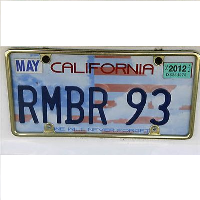Specialty License Plate Revenues Are Poorly Collected and Often Misspent

California drivers who spend extra dollars on specialty license plates for distribution to programs they support aren’t getting their money’s worth.
Audits by the Department of Finance and the California State Auditor found millions of dollars improperly handled by the Department of Motor Vehicles (DMV) and the agencies it dispersed the funds to.
A report (pdf) by the auditor found that the state failed to collect $22 million generated by the plates over two years, ending in mid-2012, and that money dispersed wasn’t always spent properly. Specialty license plates have generated $250 million over 20 years, but there has never been a comprehensive audit of them . . . until now.
The DMV is in charge of collecting the fees and distributing them to the appropriate agencies. The auditor found that the DMV “potentially undercharged” plate owners $10.2 million, failed to collect another $12 million from retention fees related to the plates and overstated its costs for administering the environmental fund by $6.3 million. Around 1.3 million plates were issued, renewed or transferred in fiscal year 2011-12.
The state currently has 11 specialty plates benefiting a range of causes, including aid to 9/11 families, veterans, firefighters, the arts, child health and a host of environmental efforts. Most of the environmental plate revenues go to the environmental fund, which includes benefits for Yosemite and Lake Tahoe and is the largest benefactor from specialty plates, by far.
The Legislature appropriated $40 million from the environmental fund to 24 entities in 2011-12, according to an audit (pdf) by the Finance Department. (The next largest fund, the Kid’s Plate, collected $4.66 million.)
The Finance Department looked at the six largest environmental fund recipients, representing 78% of the money allocated ($31.3 million), and found that most of them don’t identify where the money went. The audit concluded that five of the six departments spent the money on general operations, instead of “identifiable projects and programs” that the law demands. The exception was the Department of Fish and Wildlife, which received the most money, $13.5 million.
The Department of Parks and Recreation was typical of the underreporting agencies. It listed $1.7 million spent on personnel and $1.4 million on operations and equipment, but did not identify any specific projects and programs. The Tahoe Regional Planning Agency and the California Tahoe Conservancy commingled their environmental fund money with general fund revenues and also spent the money on unrelated programs.
The audit emphasized that agency failures to track environmental fund money cheated the license plate purchasers who “expect the fees they paid to be used for identifiable projects and programs.”
The report recommended that each funding recipient follow the law and identify the projects and programs it spends environmental fund money on. For several of the agencies, it is simply a matter of using tracking codes already available within their accounting systems.
–Ken Broder
To Learn More:
Audit Finds Problems with Calif. Specialty Plates (by Don Thompson, Associated Press)
Auditor: CA Special License Plate Money Not Collected, Misspent (by Torey Van Oot, Sacramento Bee)
Gov. Jerry Brown Orders Audit of Specialty License Plate Program (by Hannah Dreier, Associated Press)
Audit Finds Issues with ST8PL8S (by Christopher Cadelago, U-T San Diego)
“We Will Never Forget” Fund Mostly an Afterthought (by Ken Broder, AllGov California)
Review of the California Environmental License Plate Fund (California Department of Finance) (pdf)
Special Interest License Plate Funds (California State Auditor) (pdf)
- Top Stories
- Controversies
- Where is the Money Going?
- California and the Nation
- Appointments and Resignations
- Unusual News
- Latest News
- California Forbids U.S. Immigration Agents from Pretending to be Police
- California Lawmakers Urged to Strip “Self-Dealing” Tax Board of Its Duties
- Big Oil’s Grip on California
- Santa Cruz Police See Homeland Security Betrayal in Use of Gang Roundup as Cover for Immigration Raid
- Oil Companies Face Deadline to Stop Polluting California Groundwater





